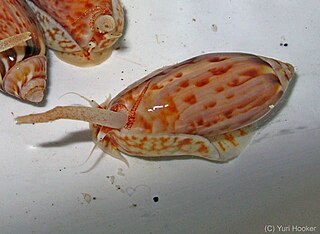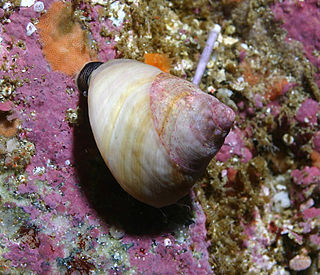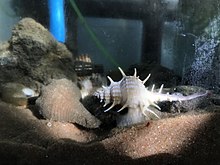Orthogastropoda was a major taxonomic grouping of snails and slugs, an extremely large subclass within the huge class Gastropoda according to the older taxonomy of the Gastropoda.
Volutoidea is a taxonomic superfamily of predatory sea snails, marine gastropod mollusks in the clade Neogastropoda.

Littorinimorpha is a large order of snails, gastropods, consisting primarily of sea snails, but also including some freshwater snails and land snails.

Stylommatophora is an order of air-breathing land snails and slugs, terrestrial pulmonate gastropod molluscs. This taxon includes most land snails and slugs. Stylommatophorans lack an operculum, but some close their shell apertures with temporary "operculum" (epiphragm) made of calcified mucus. They have two pairs of retractile tentacles, the upper pair of which bears eyes on the tentacle tips. All stylommatophorans are hermaphrodites.

Olive snails, also known as olive shells and olives, scientific name Olividae, are a taxonomic family of medium to large predatory sea snails with smooth, shiny, elongated oval-shaped shells.

Buccinoidea is a taxonomic superfamily of very small to large predatory sea snails, marine gastropod mollusks.

The Buccinidae are a very large and diverse taxonomic family of large sea snails, often known as whelks or true whelks.

Basommatophora was a term that was previously used as a taxonomic informal group, a group of snails within the informal group Pulmonata, the air-breathing slugs and snails. According to the taxonomy of the Gastropoda, whenever monophyly has not been tested, or where a traditional taxon of gastropods has now been discovered to be paraphyletic or polyphyletic, the term "group" or "informal group" was used.

Trochoidea is a superfamily of small to very large vetigastropod sea snails with gills and an operculum. Species within this superfamily have nacre as the inner shell layer. The families within this superfamily include the Trochidae, the top snails. This superfamily is the largest vetigastropodan superfamily, containing more than 2,000 species.
The taxonomy of the Gastropoda as it was revised in 2005 by Philippe Bouchet and Jean-Pierre Rocroi is a system for the scientific classification of gastropod mollusks. The paper setting out this taxonomy was published in the journal Malacologia. The system encompasses both living and extinct groups, as well as some fossils whose classification as gastropods is uncertain.

Cancellariidae, common name the nutmeg snails or nutmeg shells, are a family of small to medium-large sea snails, marine gastropod mollusks in the clade Neogastropoda. Some of the shells of the species in this family resemble a nutmeg seed.
The taxonomy of the Gastropoda, as revised by Winston Ponder and David R. Lindberg in 1997, is an older taxonomy of the class Gastropoda, the class of molluscs consisting of all snails and slugs. The full name of the work in which this taxonomy was published is Towards a phylogeny of gastropod molluscs: an analysis using morphological characters.

Vetigastropoda is a major taxonomic group of sea snails, marine gastropod mollusks that form a very ancient lineage. Taxonomically the Vetigastropoda are sometimes treated as an order, although they are treated as an unranked clade in Bouchet and Rocroi, 2005.

The Cerithioidea is a superfamily of marine, brackish water and freshwater gastropod containing more than 200 genera. The Cerithoidea are included unassigned in the subclass Caenogastropoda. The original name of this superfamily was Cerithiacea, in keeping with common superfamily endings at the time.

Olivoidea is a taxonomic superfamily of minute to medium-large predatory sea snails, marine gastropod mollusks in the order Neogastropoda.
Pseudolividae is a taxonomic family of medium-sized sea snails, marine gastropod mollusks in the superfamily Olivoidea.

Mitroidea is a superfamily of Recent and fossil sea snails, marine gastropod mollusks within the order Neogastropoda.

The Bellolividae is a taxonomic family of sea snails, marine gastropod molluscs in the superfamily Olivoidea.

The Benthobiidae is a taxonomic family of sea snails, marine gastropod molluscs in the superfamily Olivoidea.

Turbinelloidea is a superfamily of sea snails in the order Neogastropoda. It comprises the following families:














